

|
Back to |
| The Front Page |
| News & Features |

|
Croquet in historic Scotland |
||||||||||
|
by Fergus McInnes; photos by Fergus McInnes and John Clark and from the archives of Midlothian Library Posted May 23, 2011
|
||||||||||
|
||||||||||
While the historical tides of English croquet since the mid 19th century were reflected throughout the United Kingdom, there are noticeable differences between croquet in England and croquet in Scotland in the 21st Century. The most visibly delightful difference is the prevalence of Scottish courts in the shadow of dramatic castles or other historic architecture, with memorably spectacular views.
After 150 years of stop-and-start development, the second decade of the 21st Century is the best time to explore croquet in Scotland, with its clubs scattered around the country. The best places to begin are Edinburgh and Glasgow, where an abundance of courts combines with excellent surfaces and historic surroundings. (At none of these courts will you look around and imagine youíre still in Kansas!) The ambience alone would make you want to fly to Scotland for your own exploration, preferably in the month of June, when the clubs make some of their most elaborately organized events catering for visitors Ė visitors who already play croquet, and visitors who do not; visitors wanting to learn the game, and visitors who simply want to see it played in beautiful and historic surroundings.
The birthplace of golf created space for croquet within two decades of the mallet sportís introduction in England by John Jaques. The first Championship of Scotland was a one-day affair in August 1870, on the Beechgrove croquet lawns in the small town of Moffat, with games limited to one hour. Though the event was publicly advertised, only six players entered, according to the Glasgow Herald. Croquet at Beechgrove continued through the 1870ís, but in 1880 the Beechgrove croquet lawns, like Englandís Wimbledon courts, were converted to tennis, the new lawn sport craze mixing men and women in competition. So organized croquet was eclipsed in both England and Scotland until the late 1890ís, when the English Croquet Association somehow shook off the curse of lawn tennis and re-established itself.

|
| Croquet on the Beechgrove lawns in the little town of Moffat started in 1870 and lasted only ten years, with all the lawns converted to tennis in 1880. |
The parallel re-establishment in Scotland produced a new croquet complex in Edinburgh in 1897. Edinburgh still boasts two clubs less than four miles apart, both of them worth visiting for the beauty of the courts and the settings alone.

|
| It's easy to see why this Edinburgh Club at Lauriston Castle is so popular with both players and visitors - and this photo doesn't include the sweeping view of the Firth of Forth from the castle grounds. |
From 1897 to 1914 the Scottish Championship was held at the Edinburgh Hydropathic (now part of Napier Universityís Craiglockhart campus), which by 1911 had nine croquet lawns, regarded as among the best in Britain. The championship was normally only one event over six days of croquet, attracting an average entry of about two dozen, including visitors Ė and indeed several winners Ė from England and Ireland. In 1911 two of the competitors were from Australia.
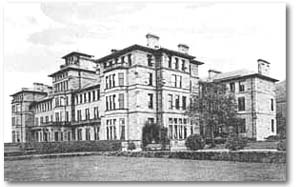
|
| Until the late nineteens, nine of the best courts in Britain were here, and if you look carefully, you can still see their outlines. In 1917 the Edinburgh Hydropathic became a hospital, then a college and more lately was incorporated into a university. |
In 1917 the Edinburgh Hydropathic was taken over as a hospital, and it has since been a convent and teacher-training college as well as part of a university, but many of the lawns are still easily identified nearly a hundred years after they were last used.
Eclipse and resurgence
From the First World War until 1950 the history of croquet in Scotland is almost blank; but not quite. Golf croquet was played in North Aberdeenshire, mainly among farmers and ministers, while the Association game was kept alive by one club, a ladiesí group attached to the Livilands Bowling Club in Stirling. Women were not allowed to play bowls in Scotland, and so in 1913 they petitioned for the use of part of the bowling club grounds for croquet. It was not until 1921 that the bowlers allowed this incursion of croquet, but that croquet club continued until 1976, playing old-style croquet with two pegs until the end.
In 1949 the Monquhitter Croquet Club in Aberdeenshire was the first club to start up after the Second World War. It was another ladiesí club on bowling greens, playing only golf croquet. Other golf croquet clubs were started in the same area, and the Aberdeen Press and Journal frequently carried reports of their matches and events.
The first club to start after WWII playing Association Croquet was in Edinburgh. A court had been discovered at Lauriston Castle in 1950, and regular play started there later in the season.
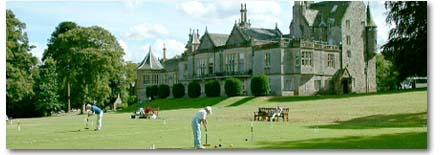
|
| A sunny day brings out players and spectators at Lauriston Castle in Edinburgh. |
Members of the Edinburgh club responded to a plea for organizing help from a Glasgow group, where a piece of ground was found in Pollok Estate on the south side of the city, and the Glasgow Croquet Club had its first playing season there in 1960. One of the two courts was level, but the other had a drop of over six feet from end to end. Several more clubs were formed in central Scotland over the next few years, though unlike those in Edinburgh and Glasgow they have not survived to the present day.
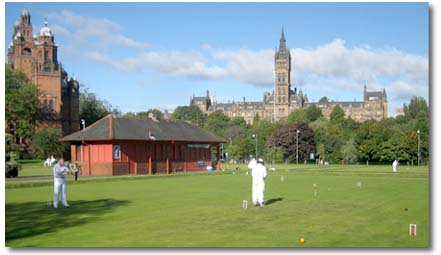
|
| Scotlandís best site for large events beginning 2015 will be the four reconstructed bowling greens (with new pavilion) in Glasgow at Kelvingrove. The Scottish association has bid for the 1015 Home Internationals, contested by five-player teams from England, Scotland, Wales and Ireland. The red sandstone building on the left is the Kelvingrove art gallery, and the enormous building in the background with the center tower is part of Glasgow University. |
In 1968 the first Scottish Open Championship of the modern era was played, with the finals at Lauriston Castle on the 6th of July. In 1969 the first week-long Edinburgh Tournament was held, an event repeated in 1972 and continued ever since Ė for its first 10 years at Dunfermline College of Physical Education, and from 1981 onwards on the cricket ground of Fettes College.
Independence from Englandís Croquet Association
Until the early 1970s croquet in Scotland was under the auspices of Englandís Croquet Association. The impetus to set up a separate Scottish association came when the Glasgow Club wished to purchase land to replace its original sloping site, and sought funding from the Scottish Sports Council. The Sports Council could deal only with autonomous Scottish governing bodies; and so in 1974 the Scottish Croquet Association (SCA) was formed, and the Glasgow Club got its grant.
Another club was formed around 1980 at the Bush Estate, an Edinburgh University agricultural campus to the south of Edinburgh, and with the aid of another Scottish Sports Council grant the National Croquet Centre was opened there in June 1988, with two newly constructed courts and a third (the original court) nearby. This was the venue for many of the Scotlandís tournaments and matches from then until 2000, when the Bush Club relocated to a pair of disused bowling greens at the Meadows, near the city centre.
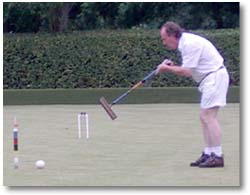
|
| Brian Murdoch prepares to peg out during Scotlandís inaugural East v West match at the Meadows Club. |
The Meadows Club, less than three miles from Lauriston Castle, is the country's main venue for the development of the game in Scotland at all levels and for hosting major national competitions and international events.
Croquet in Scotland today
The Edinburgh Club still plays in the beautiful setting of Lauriston Castle with its view across the Firth of Forth. Originally it had one full-size court with some undulations and two narrow sloping ones, but levelling works were completed in 2004 have resulted in two level full-size courts, with the third remaining narrower and on a slope. The club has about 50 members.

|
| Edinburgh Club Captain John Clark in play with the Firth of Forth and Fife in the background. Note the courtside benches facing opposite directions, giving passers-by a choice between watching croquet and viewing the Firth of Forth and Fife. |
The Glasgow Club, in contrast, has moved several times over the years: from one site to another at Pollok Park in 1973, to bowling greens at Glasgow Green West in 1983, to Glasgow Green East in 1988, and then to Kelvingrove Park in 1995. It is now in a temporary location, again on bowling greens, at Alexandra Park in Dennistoun, while the Kelvingrove greens are being reconstructed as the bowls venue for the Commonwealth Games in 2014. After the Games the four newly-built greens and pavilion at Kelvingrove will become available to both bowlers and croquet players.
At Auchincruive, the Scottish Agricultural Collegeís campus near Ayr, golf croquet has been played since the 1960s, and Association croquet since the 1970s. The club has one nearly full-size court, with some tricky sloping corners, and one small court. The highlight of its annual programme is a doubles golf croquet tournament (using the old rules) held at midsummer, and it is also the venue for the SCAís inter-club singles tournament, the Basil Townsend Quaich.
The Meadows Club (formerly the Bush Club) is now the largest in the Scottish Association, with around 80 members. It hosts many of Scotlandís tournaments, and also has its own full programme of club sessions, with a fairly even balance between Association and golf croquet. Its courts are the flattest in Scotland, and usually the fastest, though the sandy composition of the ground makes it difficult to achieve challenging hoops.
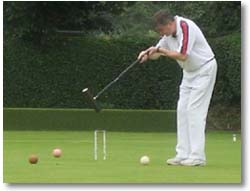
|
| Keith Aiton lines up a rush after his 4-back peel, playing the first sextuple ever seen in Scotland, at the Meadows, August 2008. |
The croquet group of the Royal Northern and University Club plays at Crathes Castle near Aberdeen. Although not affiliated to the Scottish Croquet Association, the group benefits from the involvement of three times Scottish Champion Bob Burnett, who has a family connection with Crathes.
The Kinross Club was founded in 1995 by Allan Ramsay (a founder member of the Bush Club and SCA Development Officer) and plays at the Green Hotel. It has very few members at present, but still hosts its own one-day handicap tournament in June and is the venue for the Scottish Short Croquet Championship in August each year.
The Fife Croquet Club, founded in March 2007, plays at Hill of Tarvit, a National Trust for Scotland property near Cupar. It has a reciprocal membership arrangement with the Kinross Club.
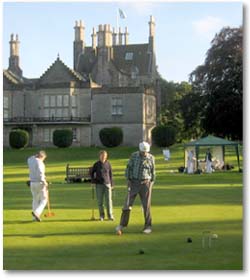
|
| An interclub team event between Edinburgh's two clubs is played at Lauriston Castle. |
Another recent start-up (not affiliated to the SCA at present) is the club in Dundonald in Ayrshire Ė a golf croquet club which has a large membership and only one court, so that much of the time is spent watching and socialising.
Over the years since 1974, Scottish sides have played teams from England, Ireland, Wales, Jersey, Guernsey, France, Switzerland, Italy, the USA, Canada, South Africa, Australia, New Zealand and Japan. Several Scots have also been members of the Great Britain MacRobertson Shield team.
So, 141 years after the first Scottish Championship, croquet is alive and well in Scotland. Come and see for yourself! If you come in the summer, you may even enter an organized event played in the shadow of one of Scotlandís historic castles.
CONNECTING WITH CROQUET CLUBS AND EVENTS IN SCOTLAND
Visiting players are welcome to take part in most tournaments listed on the Scottish Croquet Association website; click on the event name in the events list for information on how to enter. For those who are new to croquet, the Edinburgh Croquet Club and the Meadows Croquet Club both run an introductory course in May and June each year. All of Scotlandís affiliated clubs welcome newcomers to their regular sessions, whether they just want to watch or are interested in learning croquet and joining the club. The official website of the Scottish Croquet Association lists all the affiliated clubs and contact points. Its webmaster is the author of this article, Fergus McInnes.
Much of this article is based on David Appletonís history of the Scottish Championship from 1870 to 1914, which contains additional detail on the players and trophies and can be found on the Scottish Croquet website. Further historical details came from Ian Wrightís article in the Scottish Croquet Association Handbook.